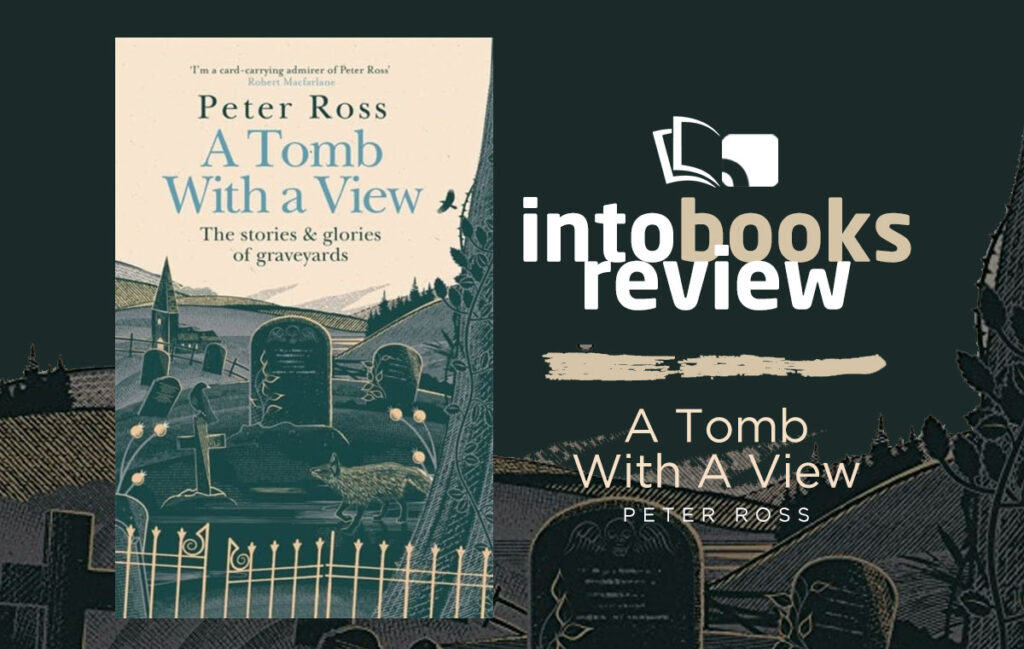Into Books Review: A Tomb With A View by Peter Ross

Book: A Tomb With A View
Author: Peter Ross
Publisher: Headline, 2020
Peter Ross has been fascinated by graveyards since he was young, tracing the letters and symbols of tombstones in the Old Town Cemetery in Stirling, near his grandparents’ home and reading the slabs like ‘shelves full of stories’. He now lives by Cathcart Cemetery in Glasgow, finding comfort there since Covid-19 has spread throughout the world and forced us to look the concept of mortality in the eye. It seems only natural that the award-winning journalist and author of Daunderlust and The Passion of Harry Bingo would use this enthusiasm to create a volume such as A Tomb With a View.
Ross takes us down a balanced path of love and remembrance, seeing life and death from all angles and leading us on a non-biased, compassionate journey. He adds touches of myth and mystery as he introduces us to the flamboyance of Brompton’s ‘Queerly Departed’ tour in London and his beloved Cathcart Cemetery, home to the Gorbals Vampire. From the ghost of Greyfriars’ Bobby in Edinburgh to the Paramilitary Burials at Milltown Cemetery in Belfast, the impact of Ross’ extensive research, combined with the poetics of his prose, is as grim and powerful as the Reaper himself.
He moves along a non-linear path, from accounts of loneliness and mental illness to encounters with religious tension – including the burial of murdered Irish journalist Lyra McKee. In London’s Highgate, he compares the attention paid to the tombs of people such as Karl Marx and George Elliot, to the privacy of George Michael’s grave, before focusing on the story of the ancient graveyard cedar, so lovingly cared for, but eventually replaced by a young sapling. The harrowing cillacs in Ireland, where unbaptised infants are laid to rest in remote fields or on the edges of church grounds and society itself, provide a stark, emotional contrast.
In 2018 Danny Boyle co-ordinated a series of surreal sand portraits along the coasts of Britain to mark the centenary of the Great War. They were extraordinary reminders of the unprecedented scale of loss. These physical and visceral tributes, alongside later projects, such as Peter Jackson’s They Shall Not Grow Old and Sam Mendes’ 1917, brought the insanity of ‘the war to end all wars’ to the forefront of 21st century minds. I would now rank Ross amongst them, in his pathos for the fallen, as he writes of two bodies which lie close to one another in the Hebrides:
The naval officer and the Unterseebootman: enemies in life, neighbours in death.
The simple stones looked after by the Commonwealth War Graves Commission (CWGC), in locations as remote and scattered as North Uist and Loch Shiel, are remarkable, but Ross also records the messages of conscientious objectors, scratched into the walls at Richmond Castle, Yorkshire:
The only war worth fighting is the class war.
One hundred years after the end of the First World War, men who fought in it are still being buried in Belgium and France, as their bodies are retrieved and identified.
The grieving, the caretakers, the gravediggers and the guides are all given prominence in this volume, but nowhere more poignantly than in the story of Shane MacThomáis, the Dublin man who tended the tombs in Glasnevin Cemetery so diligently. Working at Glasvenin gave him hope and purpose before his own tragic end:
I look at all the headstones and I imagine all the people here, all the stories that are yet to be discovered and told. And it lifts my spirit.’
That spiritual uplift can be found in cemeteries is a central theme of the book. In the same chapter Ross takes us to the graves of Republicans in Dublin, paying equal respect to that previously shown to sectarian sites, before turning our attention to diverse cultural beliefs about death and burial.
Muslim funerals, including those for the Grenfell Dead are explained in humble detail, along with descriptions of ossuaries from centuries past, but the rights of people to perform natural burials, without religious ceremony is one of the most eloquent chapters of the book, bringing universal themes of mental health, loss and love to a head. This most moving of chapters, towards the end of the book, convinced me that no matter what methods we choose:
… the dead and the living are close kin.
Completed in March 2020, on the eve of the first Covid-19 Lockdown, A Tomb with a View is a lyrical path through cemeteries, gardens and sacred grounds. It is as real and varied as wandering the graves yourself, daring you to think of your own mortality and how you might choose to be remembered.
L M Mulholland
@LorettaMulholl1
